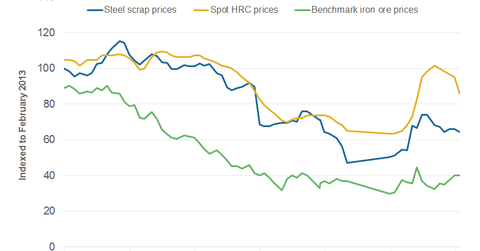Could Steel Scrap Prices Follow Steel Prices Lower?
Steel scrap prices could follow steel prices lower. Steel mills might negotiate hard with scrap suppliers as steel prices pare some of their 2016 gains.
Nov. 20 2020, Updated 12:10 p.m. ET

Steel scrap prices
Previously, we saw that rising Chinese steel prices have been accompanied by a spike in iron ore and met coal prices as well. Meanwhile, for US steel producers like Nucor (NUE) and Steel Dynamics (STLD), steel scrap pricing is a bigger driver than seaborne iron ore prices.
The above graph shows the movement in spot HRC (hot-rolled coil) prices plotted against benchmark-shredded scrap, according to data compiled by the Metal Bulletin. As you can see, spot HRC prices have been moving in tandem with scrap prices.
Steel prices have fallen
However, while HRC prices have fallen steeply from their peak, steel scrap has been holding somewhat steady. In our view, steel scrap prices could follow steel prices lower. Steel mills might negotiate hard with scrap suppliers as steel prices pare some of their 2016 gains. As US steelmakers have started to cut their production in response to rising imports, we could see steel scrap demand also moderate in the coming months. This could put more pressure on scrap prices.
The steel industry might be looking at a tough 2H16. Read What Will Santa Bring for US Steel Producers This Christmas? to learn more about the steel industry’s outlook.
ETF alternatives
The SPDR S&P Metals and Mining ETF (XME) is ~50% invested in US-based steel companies. This ETF could be an alternative way to play the steel industry for investors who want to avoid the hassles of picking individual stocks. Together, U.S. Steel Corporation (X) and AK Steel (AKS) form 7.7% of XME’s portfolio.
Please visit Market Realist’s Steel page for recent developments in this industry.
